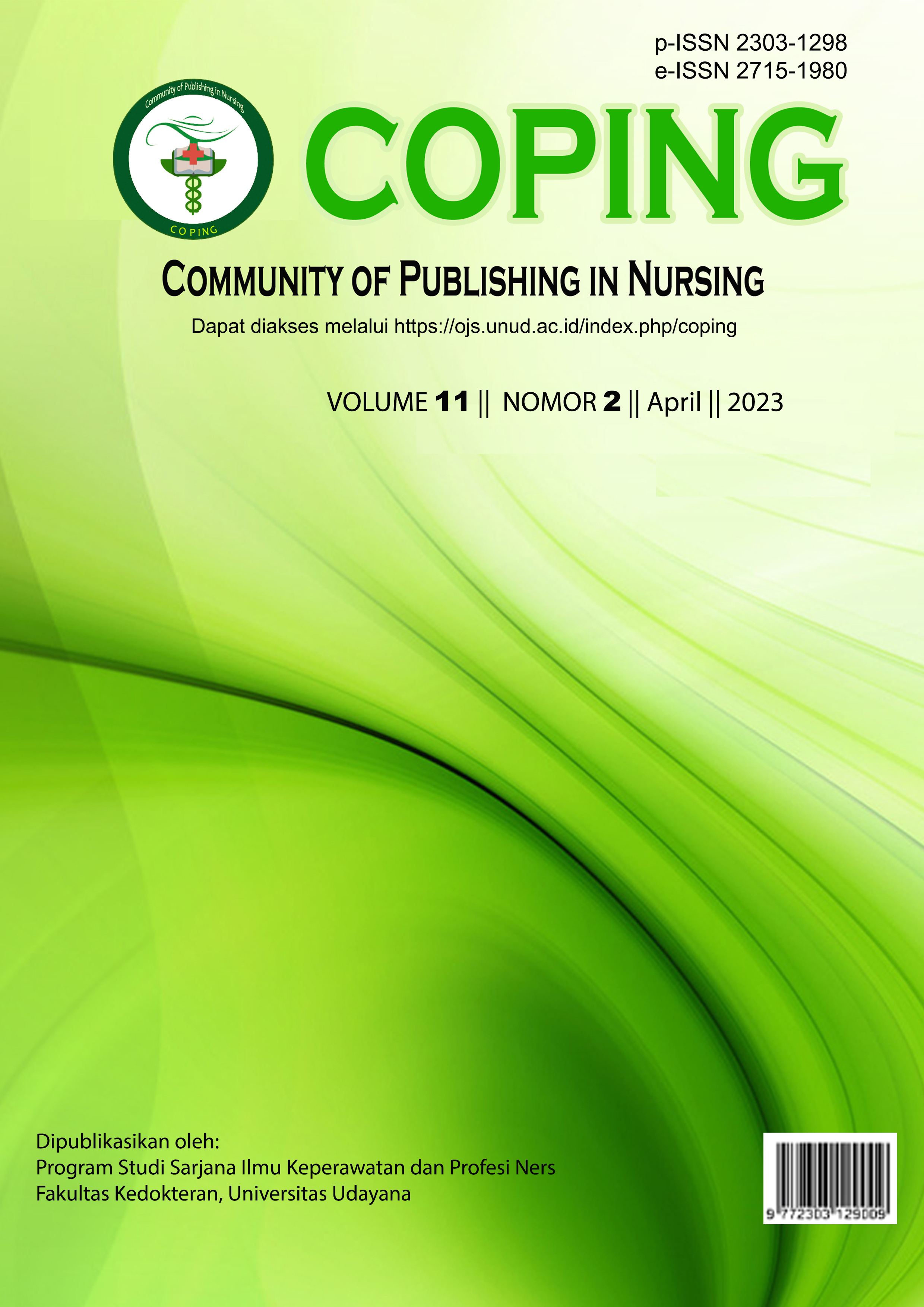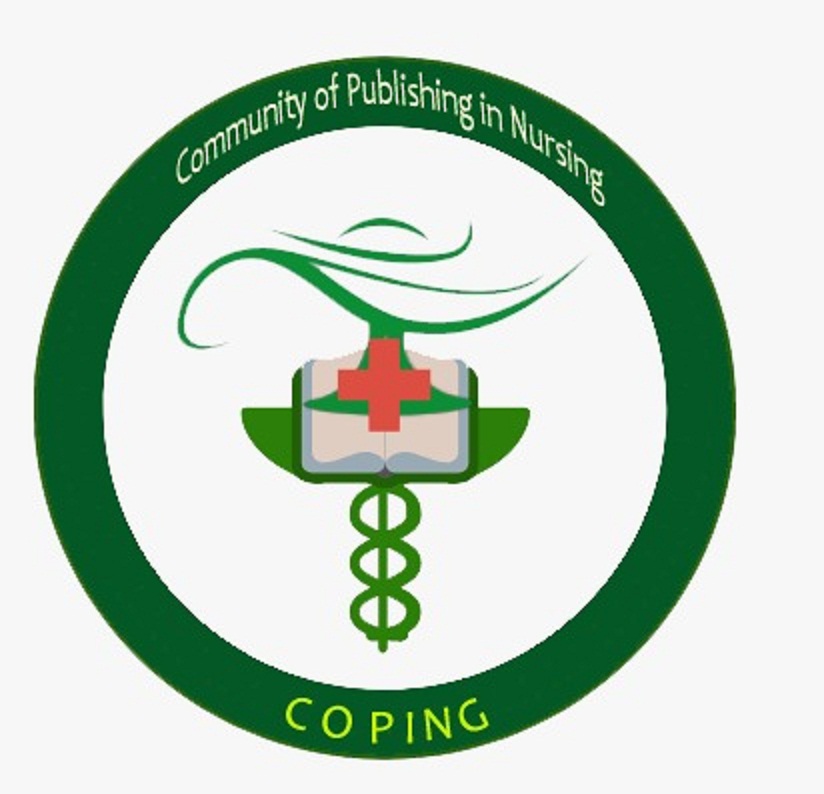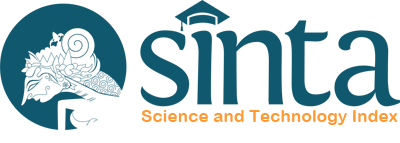KORELASI KARAKTERISTIK DENGAN PENGETAHUAN PERAWAT MENGENAI AUSTRALIAN TRIAGE SCALE
Abstrak
Triage is a very essential aspect of emergency services, especially intrahospital. Triage in its technical implementation is carried out by health workers who first meet patients in the emergency room. Health workers who are in charge of prioritizing patients using triage, must at least contain interpretation of clinical history and physiological assessment to label, and place patients in the appropriate area. Fast and precise triage is the key to successful performance in providing emergency services. Assessing the priority of patients who are inappropriate for their condition has the risk of increasing morbidity rates, affecting the results of care, or outcomes that will be determined. This study aims to determine the correlation between characteristics and knowledge of health workers regarding ATS triage at Wangaya Hospital, Denpasar City. This study is a descriptive correlative study with a cross sectional approach. This research was conducted in the emergency room of Wangaya Hospital, Denpasar City within a period of 1 month in November 2022. The sample in this study amounted to 31 health workers consisting of 24 nurses and 7 doctors. Samples were selected using total sampling technique. Gamma test was used to determine the relationship between the two variables. The results showed that from the characteristics of health workers, only the history of triage training had a statistical relationship with ATS triage knowledge with a p-value of 0,021. There was no statistical association between age, gender, education history, BTCLS training history, PPGD training and length of employment history with ATS triage knowledge. Regular triage training can be carried out with roleplay or video methods to increase health workers' knowledge of ATS triage.
##plugins.generic.usageStats.downloads##
Referensi
Bijani, M., & Khaleghi, A. A. (2019). Challenges and Barriers Affecting the Quality of Triage in Emergency Departments: A Qualitative Study. Galen Medical Journal, 8. https://doi.org/10.31661/gmj.v8i0.1619
Erna, D. W., Abu, B., & Santoso, W. (2015). Hubungan pengetahuan perawat tentang pemberian label triase dengan tindakan perawat berdasarkan label triase di IGD Rumah Sakit Petrokimia Gresik. Critical, Medical & Surgical Nursing Journal, 4(1), 1-5.
Fitri, S., Rasyid, T. A., & Tobing, V. Y. (2022). Hubungan Pengetahuan Perawat Terhadap Pelaksanaan Triase Anak Di Instalasi Gawat Darurat (IGD). 7(10). https://jurnal.syntaxliterate.co.id/index.php/syntax-literate/article/view/9638/5659
Garbez, R., Carrieri-Kohlman, V., Stotts, N., Chan, G., & Neighbor, M. (2010). Factors Influencing Patient Assignment to Level 2 and Level 3 Within the 5-Level ESI Triage System. Journal of Emergency Nursing, 37(6), 526–532. https://doi.org/https://doi.org/10.1016/j.jen.2010.07.010
Gligorijevic, D., Stojanovic, J., Satz, W., Stojkovic, I., Schreyer, K., Del Portal, D., & Obradovic, Z. (2018). Deep attention model for triage of emergency department patients. SIAM International Conference on Data Mining, SDM 2018, January, 297–305. https://doi.org/10.1137/1.9781611975321.34
Hasibuan, I. M., Yunita, J., & Sari, S. M. (2021). Determine The Effect of The Leadership Style of The Head of The Room On The Performance of Nurses in The Inpatient Roomof The Rokan Hulu Regional General Hospital in 2020. Journal of Midwifery and Nursing, 3(1), 1–8.
Iversen, A. K. S., Kristensen, M., Østervig, R. M., Køber, L., Sölétormos, G., Forberg, J. L., Eugen-Olsen, J., Rasmussen, L. S., Schou, M., & Iversen, K. K. (2019). A simple clinical assessment is superior to systematic triage in prediction of mortality in the emergency department. Emergency Medicine Journal, 36(2), 66–71. https://doi.org/10.1136/emermed-2016-206382
Javadi, S., Salimi, T., Sareban, M. T., & Dehghani, M. A. (2016). Knowledge and Practice of Nurses Regarding Patients’ Triage in Emergency Department. In Iranian Journal of Emergency Medicine (Vol. 3, Issue 1, pp. 15–22).
Jordi, K., Grossmann, F., Gaddis, G. M., Cignacco, E., Denhaerynck, K., Schwendimann, R., & Nickel, C. H. (2015). Nurses’ accuracy and self-perceived ability using the Emergency Severity Index triage tool: A cross-sectional study in four Swiss hospitals. Scandinavian Journal of Trauma, Resuscitation and Emergency Medicine, 23(1). https://doi.org/10.1186/s13049-015-0142-y
Khairina, I., Malini, H., & Huriani, E. (2020). Pengetahuan Dan Keterampilan Perawat Dalam Pengambilan Keputusan Klinis Triase. Link, 16(1), 1–5. https://doi.org/10.31983/link.v16i1.5449
Nurbiantoro, D. A., Septimar, Z. M., & Winarni, L. M. (2020). Hubungan Pengetahuan Dengan Keterampilan Perawat Dalam Pelaksanaan Triase Di RSUD Kota Tangerang. Jurnal Health Sains, 1(6), 414–426. http://jurnal.healthsains.co.id/index.php/jhs/article/view/75/126
Nursanti, D. M. Y., & Dinaryanti, R. S. (2022). Hubungan Tingkat Pengetahuan Tentang Triage Dengan Pelaksanaan Respon Time Perawat Dalam Pelaksanaan Triage di IGD Rumah Sakit Dr Suyoto: Correlation Level of Knowledge of Nurses About Triage with The Implementation of Nurse Response Time in Triage Implementation in ER Dr Suyoto Hospital. Jurnal Ilmiah Keperawatan (Scientific Journal of Nursing), 8(1), 193-199.
O’Connor, E., Gatien, M., Weir, C., & Calder, L. (2014). Evaluating the effect of emergency department crowding on triage destination. International Journal of Emergency Medicine, 7(1), 1–7. https://doi.org/10.1186/1865-1380-7-16
Rahmati, H., Azmoon, M., Kalantari Meibodi, M., & Zare, N. (2013). Effects of Triage Education on Knowledge, Practice and Qualitative Index of Emergency Room Staff: A Quasi-Interventional Study. Bulletin of Emergency and Trauma, 1(2), 69–75. http://www.ncbi.nlm.nih.gov/pubmed/27162827%0Ahttp://www.pubmedcentral.nih.gov/articlerender.fcgi?artid=PMC4771226
Sari, D. R., & . S. (2018). Sikap Dan Pengetahuan Perawat Berhubungan Dengan Pelaksanaan Triage. Jurnal Kebidanan, 9(02), 154. https://doi.org/10.35872/jurkeb.v9i02.317
Suindrayasa, I. M. (2018). Gambaran Pengetahuan Perawat Mengenai Triase di Instalasi Gawat Darurat RSUP Sanglah Denpasar.
Varndell, W., Hodge, A., & Fry, M. (2019). Triage in Australian emergency departments: Results of a New South Wales survey. Australasian Emergency Care, 22(2), 81–86. https://doi.org/10.1016/j.auec.2019.01.003








